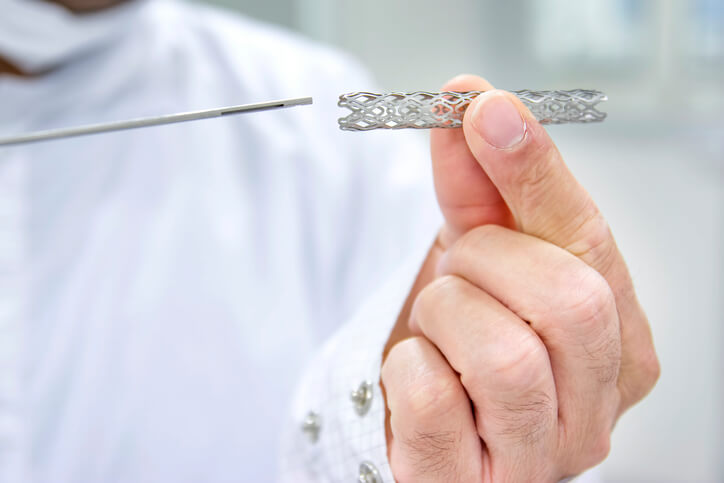A commonly asked question is whether an inferior vena cava (IVC) filter is the same as a stent. The short answer is, no. While doctors may implant both devices into patients’ blood vessels, the truth is that they are very different. And the complications involved with these devices are also unique.
Stents and IVC filters are not the same, and they have completely different purposes. But it is possible for patients to have both devices, under certain circumstances.
What is an Inferior Vena Cava Filter?
An IVC filter is a small, cage-like device that your doctor inserts into your inferior vena cava. (The inferior vena cava is the biggest vein in your body.) Patients at risk for blood clots in their legs (i.e., deep vein thrombosis, or DVT) may need an IVC filter. You’re most likely to get an IVC filter if the clot could travel to your lungs, causing a pulmonary embolism. If you’re a DVT or PE patient, your doctor may suggest inserting a filter into your inferior vena cava. A surgeon will insert the cage-like filter into your inferior vena cava to catch blood clots before they travel elsewhere. Because all inferior vena cava filters have thin metal wires called struts, leaving them in permanently can cause serious injuries.
What Risks Come With Using Inferior Vena Cava Filters?
While an IVC filter won’t stop new clots from forming, it can stop existing ones from triggering a pulmonary embolism. Despite these potential benefits, IVC filters are controversial and only work well on a temporary basis. That’s because you can still have a stroke, PE or DVT after your filter placement. Plus, IVC filters can cause serious complications, including the very health issues they’re designed to prevent. Patients who leave these devices in too long risk the following complications:
- Your filter can tilt and loosen inside your inferior vena cava, allowing it to travel to your heart and/or lungs
- The device may break into several smaller pieces, leaving metal shards free to travel through your body
- Metal struts that break off can perforate your inferior vena cava wall or other nearby organs, which causes internal bleeding
One reason for concern is how difficult IVC filters are to retrieve after placement — often, doctors simply leave them in. According to a Boston Medical Center study, doctors remove less than 1 in 10 filters upon discharge. Some believe that happens because doctors can charge patients more for device removal in outpatient settings, such as clinics. However, the FDA issued guidelines in 2013 that recommend scheduling IVC filter removal between 29 and 54 days after placement. According to the agency, patients should remove an inferior vena cava filter as soon as DVT and PE risks subside. The longer the devices stay in patients’ bodies, the higher their chances for life-threatening internal injuries. It’s also harder for doctors to remove the device all in one piece the longer it stays inside someone’s body.
What is a Stent?
Stents come in many different varieties, but most are small mesh or metal tubes. Surgeons insert them into smaller veins or arteries to keep those vessels open, so blood can continue to flow normally. Vein stents, in particular, are often placed inside large abdominal or pelvic veins (like the femoral artery).
However, stents are not used for the same reasons a doctor might place an IVC filter. Arteries are very narrow, so catching a blood clot would just plug them up even more. Instead, doctors place stents to hold narrow or blocked veins open so blood can flow normally to your heart.
Could I Have Both an IVC Filter and a Stent?
It’s possible to have both devices inside your body at the same time. If your doctor places a permanent filter and cannot remove it, then you may have both devices. Stents can hold certain major arteries and vessels open (like the inferior vena cava) for medical device placement. And doctors can put in stents around already-existing IVC filters or other medical implants.
What Patients With IVC Filter Injuries Can Do
If you have complications after getting an IVC filter, you may qualify for a cash settlement from the device’s manufacturer. Many patients received faulty devices that were later recalled due to high injury reports, like the Bard G2 Recovery filter. To see if you may qualify for financial compensation, complete your free IVC filter claim evaluation today. You’ll answer just three brief questions to confirm your eligibility and see your evaluation results in less than two minutes. Once you’ve submitted your information, an experienced lawyer will call to discuss your case.
Related: Greenfield Filter Side Effects Include Pain, Internal Injuries & Blood Clots
Mandy Voisin
Mandy Voisin is a freelance writer, blogger, and author of Girls of the Ocean and Star of Deliverance. As an accomplished content marketing consultant, mom of four and doctor's wife, Mandy has written hundreds of articles about dangerous drugs and medical devices, medical issues that impact disabled Americans, veterans' healthcare and workers' compensation issues since 2016.

